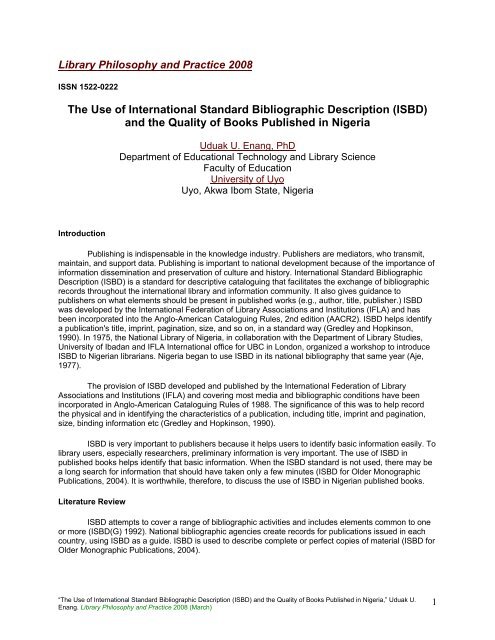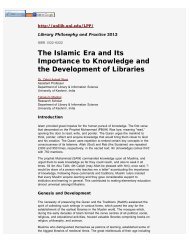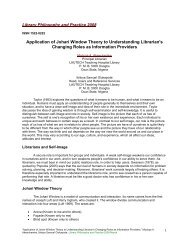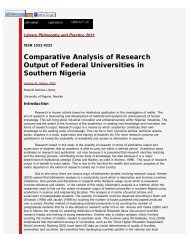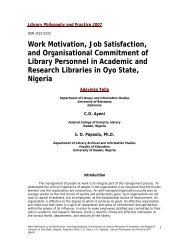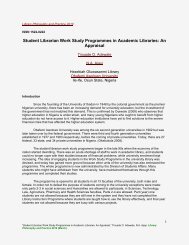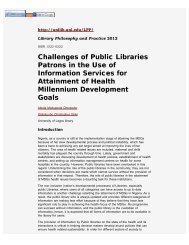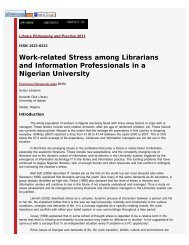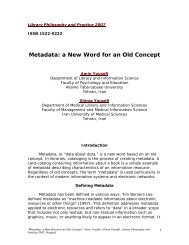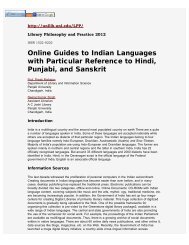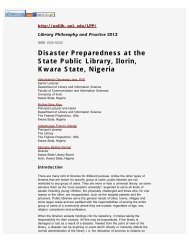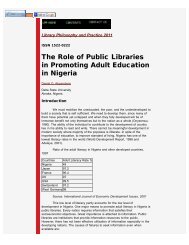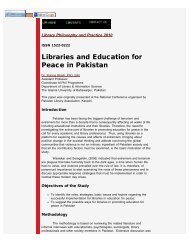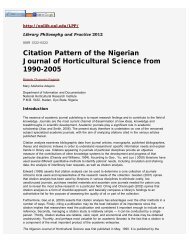Library Philosophy and Practice 2008 The Use of International ...
Library Philosophy and Practice 2008 The Use of International ...
Library Philosophy and Practice 2008 The Use of International ...
You also want an ePaper? Increase the reach of your titles
YUMPU automatically turns print PDFs into web optimized ePapers that Google loves.
Other cataloguing agencies have more choice in description, although they are still bound byISBD's prescribed order <strong>and</strong> punctuation. Factors such as name headings, subject information, uniformtitles, <strong>and</strong> so on, are not included in ISBD, but may be included in cataloguing codes (Hargler, 1991).<strong>The</strong> use <strong>of</strong> st<strong>and</strong>ards improves the consistency <strong>of</strong> bibliographic databases. <strong>The</strong> UBC programmefacilitates sharing <strong>of</strong> bibliographic data through the development <strong>of</strong> appropriate st<strong>and</strong>ards such as ISBDs<strong>and</strong> UNIMARC (Feathers <strong>and</strong> Sturges, 1997). UBC is a programme <strong>of</strong> IFLA. <strong>The</strong> basis <strong>of</strong> IFLA'sapproach to UBC was stated as early as 1969 in the resolution <strong>of</strong> the <strong>International</strong> Meeting <strong>of</strong>Cataloguing Experts (IMCE) organized by IFLA “Committee on Cataloguing” at Copenhagen, whichenvisions a system for sharing information, using st<strong>and</strong>ard bibliographic description <strong>of</strong> each publicationdistributed by a national agency in the country <strong>of</strong> origin <strong>of</strong> publication.<strong>The</strong> ProblemA continuing information explosion has driven some authors to patronize these publishers who donot meet the st<strong>and</strong>ards <strong>of</strong> ISBD. Some Nigerian publishes do not observe basic ISBD requirements, <strong>and</strong>the title pages <strong>of</strong> many publications are either missing or are lack basic information. Too much time isspent on trying to identify authorship. This study examines the use <strong>of</strong> ISBD <strong>and</strong> the quality <strong>of</strong> Nigerianpublished books.Research Method<strong>The</strong> ex post facto survey design was adopted for this study. <strong>The</strong> populations are all publishers<strong>and</strong> Nigerian published books in the Universities <strong>of</strong> Calabar, Uyo, <strong>and</strong> Port Harcourt Libraries. Onethous<strong>and</strong> books were sampled from these three university libraries <strong>and</strong> 250 publishers were alsosampled. One hypothesis was formulated to guide the study.Data Analysis <strong>and</strong> Discussion <strong>of</strong> FindingsData were analysed using Pearson Product Moment Correlation Coefficient (PPMC). <strong>The</strong>observation made from the documentary evidence from the three university libraries <strong>and</strong> the publishersguided the discussion <strong>of</strong> findings as presented in the tables shown below.Table 1:ISBD as Correlate <strong>of</strong> Quality Book Publishing in Nigeria<strong>International</strong> St<strong>and</strong>ard Bibliographic DescriptionAvailable % Not Available %Author 1,000 100 0 0Title 999 99.9 1 0.1Place <strong>of</strong> Publication 998 99.8 2 0.2Year <strong>of</strong> Publication 973 97.3 27 2.7Publisher's Name 1,000 100 0 0Copyright 700 70.0 300 30.0ISBN 941 94.1 59 5.9Bibliography 574 57.4 426 42.6Index 708 70.8 292 29.2Table 1 shows that a majority <strong>of</strong> Nigerian published books lacked some <strong>of</strong> the variables. All 1,000(100%) <strong>of</strong> the sampled Nigerian books included the author's name on the title page, while 999 (99.9%)included a title. Nearly all (998, or 99.8%) indicated the place <strong>of</strong> publication, while 973 (97.3%) included“<strong>The</strong> <strong>Use</strong> <strong>of</strong> <strong>International</strong> St<strong>and</strong>ard Bibliographic Description (ISBD) <strong>and</strong> the Quality <strong>of</strong> Books Published in Nigeria,” Uduak U.Enang. <strong>Library</strong> <strong>Philosophy</strong> <strong>and</strong> <strong>Practice</strong> <strong>2008</strong> (March)2
the year. One hundred included the publisher name. Copyright has always been a problem in Nigerianpublishing. Too many publishers do not know the implications <strong>of</strong> violating the copyright law. Only 700(70.0%) <strong>of</strong> the sample included copyright information.Table 2: <strong>The</strong> <strong>Use</strong> <strong>of</strong> ISBD <strong>and</strong> the Quality <strong>of</strong> Books Published in Nigeria12.3.Item Agreed (A) %<strong>The</strong> use <strong>of</strong> ISBD specification makes Nigeria published bookscompete with others in the books market.<strong>The</strong> use <strong>of</strong> ISBD gives publishers a sense <strong>of</strong> direction in carryingout their work.<strong>The</strong> use <strong>of</strong> ISBD specifies directive <strong>of</strong> book arrangement beforepublicationDisagreed(D)%167 66.8 83 33.264 25.6 186 74.4153 61.2 97 38.84. <strong>The</strong> use <strong>of</strong> ISBD simplifies the work done in published books 162 64.8 88 35.25. <strong>The</strong> use <strong>of</strong> ISBD makes Nigeria published books less unique 52 20.8 198 79.2Table 2 reflects the responses on the usability <strong>of</strong> ISBD from Nigerian publishers. Two thirds agreethat ISBD helps Nigerian books compete with others, <strong>and</strong> about the same number agree that it simplifiestheir work <strong>and</strong> that it helps specify directives <strong>of</strong> book arrangement before publication. Only one quarteragree that the use <strong>of</strong> ISBD gives publishers a sense <strong>of</strong> direction. Only twenty percent <strong>of</strong> respondentsagreed that the use <strong>of</strong> ISBD makes Nigerian published books less unique.Ho: <strong>The</strong> use <strong>of</strong> ISBD in books has no significant relationship to the quality <strong>of</strong> books published inNigeriaTable 3: Pearson Product Moment Correlation Coefficient Analysis <strong>of</strong> Usability <strong>and</strong> Quality <strong>of</strong>Books Published in NigeriaVariables Σ x Σ y Σ x 2 Σ y 2 Σ xy rQuality 15786.00 2.9E +07 2.9E+07 .735<strong>Use</strong> 2554.00 776204.00p
ConclusionLack <strong>of</strong> essential elements <strong>of</strong> ISBD by Nigerian publishers creates problems for cataloguers,documentalists, <strong>and</strong> library users. It hinders the process <strong>of</strong> retrieving information. <strong>The</strong> study concludesthat the use <strong>of</strong> ISBD has a significant relationship to the quality <strong>of</strong> books published by Nigerians. Authorsshould patronize reputable publishers who are well committed to ISBD <strong>and</strong> its proper arrangement inNigerian published books, which will also facilitate cataloguing.ReferencesAguolu, C. C. & Aguolu, I. E. (2002). Libraries <strong>and</strong> Information management in Nigeria. Maiduguri: Ed.Linform Services, 155-156Asein, J.O. (2002). <strong>The</strong> Nigerian copyright act with introduction <strong>and</strong> notes. Ibadan: <strong>The</strong> Copyright CouncilPublication.Edoka, B. E. (2000). Introduction to library science. Onitsha: Palma Publishing <strong>and</strong> Links CompanyLimited, 21-22Feathers, J. & Sturges, P. (eds) (1997). <strong>International</strong> encyclopedia <strong>of</strong> information <strong>and</strong> library science.London: Routledge, 12, 28, 30, 429-431.Gredley, E. & Hopkinson, A. (1990). Exchanging bibliographic data: MARC <strong>and</strong> other internationalformats. Ottawa: Canadian <strong>Library</strong> Association, London: <strong>Library</strong> Association Publication Limited; Chicago:American <strong>Library</strong> Association.Hargler, R. (1991). <strong>The</strong> bibliographic record <strong>and</strong> information technology. 2nd ed. Chicago: American<strong>Library</strong> Association.<strong>International</strong> St<strong>and</strong>ard Bibliographic Description for Older Monographic Publications. Available athttp://www.ifl.org/VII/S13/pups/Isbd2. html. Retrieved May 23, 2004ISBD(G): General <strong>International</strong> St<strong>and</strong>ard Bibliographic Description: Annotated text (1992). Rev. ed.Retrieved from: http://www.ifla.org/VII/s13/pubs/isbdg0.htmMeyers, B., Bovensculte, B. & Lowry, A. (1999). Tossing <strong>and</strong> turning all night: Publishers' dreams <strong>and</strong>nightmares. Against the Grain 10, 1-23Smith, D. C. Jr. (1990). <strong>The</strong> Economics <strong>of</strong> book publishing in developing countries. In A guide to bookpublishing. Lagos: University Press, 113Szlvassy, J. (1993). Bibliographic st<strong>and</strong>ards: An international perspective <strong>and</strong> a perspective for Laos. InA. Olden <strong>and</strong> M. Wise (ed.), Information <strong>and</strong> libraries in the developing world. London: <strong>Library</strong> AssociationPublishing, 90-95.“<strong>The</strong> <strong>Use</strong> <strong>of</strong> <strong>International</strong> St<strong>and</strong>ard Bibliographic Description (ISBD) <strong>and</strong> the Quality <strong>of</strong> Books Published in Nigeria,” Uduak U.Enang. <strong>Library</strong> <strong>Philosophy</strong> <strong>and</strong> <strong>Practice</strong> <strong>2008</strong> (March)4


